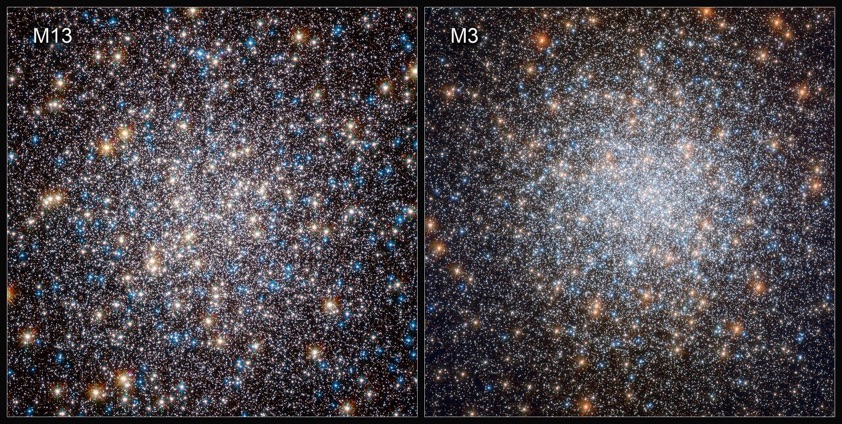The vast majority of the stars in the Universe end their lives as white dwarfs, i.e. exhausted stars which are progressively cooling and dimming. An international teams of astronomers, led by UniBO and INAF scientists, has used deep observations obtained with the NASA/ESA Hubble Space Telescope to compare the white dwarf populations in two similar (almost twin) stellar systems, discovering that some white dwarfs age more slowly than others. The discovery has been published online in the Monday 6th September 2021 issue of the prestigious journal Nature Astronomy. The first author is Jianxing Chen, a PhD student of the stellar group led by Francesco Ferraro at the Physics and Astronomy Department “A. Righi” of the Bologna University.
Stars don’t age at the same way
White dwarfs reveal the secret of slowly ageing
For any additional information please contact
Francesco Ferraro
email: francesco.ferraro3@unibo.it
tel: +390512095774
mobile: +393666357560
Indeed stars don’t age (and die) in the same way. While some of them (with masses larger than 10 solar masses) end their lives with a huge explosion, the vast majority of the stars in the Universe (approximately 98%) die out gradually, getting progressively cooler and less luminous. This final stage is named “White Dwarf” (WD) and represents a sort of stellar “old age”, during which the “naked” core of a star, which has cast off its outer layers during the last stages of its live, quietly becomes cooler and cooler (and fainter and fainter) as a function of time. In fact, WDs have no possibilities of producing energy, neither through thermonuclear reactions, nor by gravitational contraction (their density is so high that they are incompressible and can just cool down at constant radius). Because of these arguments, all WDs were thought to cool (and age) at the same rate.
The discovery published today in Nature Astronomy substantially changes this well established scenario.
HST images of the twin globular clusters M13 (left) and M3 (right)
Globular clusters are stable, tightly bound clusters of tens of thousands to millions of stars. M3 contains roughly half a million stars and lies at a distance of 33,000 light-years from Earth, in the constellation of Canes Venatici. M13 is in the constellation of Hercules, slightly closer to Earth (25,000 light-years), and it contains slightly fewer stars, only several hundred thousand. These two clusters share many physical properties such as age and metallicity. This makes M3 and M13 together a perfect natural laboratory where to test how different populations of white dwarfs cool.
“We have discovered that not all White Dwarfs age at the same way,” explained Jianxing Chen, PhD student at the Alma Mater Studiorum Universita` di Bologna and the Italian National Institute for Astrophysics, who is the first author of this research. “This was quite a surprise, as it is at odds with what is commonly believed.”
Some of WDs age more slowing than others, and the secret of this slow ageing is imprinted in their past (the last stages of their life). “Our discovery demonstrates that some WDs still preserve a residual layer of hydrogen. This layer is very very thin (1/10000 of the solar mass), but it is enough to allow stable hydrogen burning on their surface, thus guaranteeing them an unexpected source of energy, able to delay their ageing process.”, add Prof. Francesco Ferraro of the Alma Mater Studiorum Universita` di Bologna and the Italian National Institute for Astrophysics, who coordinated the study.
The discovery has been achieved thanks to deep observations acquired with the Hubble Space Telescope in two massive stellar aggregates: the globular clusters M3 and M13. These two clusters share many physical properties, such as total mass, age and metallicity. Really a sort of twins. But, as in the human case, twins are similar but with a few specific differences. In fact, their stellar populations in the latest evolutionary stages, the stages that will eventually give rise to WDs, are different. This makes M3 and M13 a perfect natural laboratory to test how different populations of WDs cool.
“The superb quality of our Hubble observations provided us with a full view of the stellar populations of the two globular clusters,” continued Mario Cadelano of the Italian National Institute for Astrophysics, co-author of the paper. “This allowed us to really contrast how stars evolve in M3 and M13.”
The comparison is really a surprise: the WD population in M13 was indeed more numerous than that of M3 in the same magnitude range (more than 460 WD were counted in M13, with respect to only 326 in M3). This was even more surprising since M13 globally contains slightly less stars than M3, and it suggested that the cooling properties of WDs in M13 are somehow different from those in M3: they were cooling down more slowing than those in M3. How is this possible?
“Indeed some theorethical models for slowly cooling WDs have been computed in the past, proposing that the reason for this slowdown is the existence of a very thin residual hydrogen-rich shell (of the order of 0.0001 solar masses) that, in principle, can still be present around the dense core of the WD and quietly produce energy.”, says Prof. Leandro Althaus from the Universidad Nacional de La Plata Argentina, the theorist, who developed the slow cooling WD models, co-author of the research.
This energy source actually slows down the cooling process, producing a class of “slowly cooling WDs”: they look similar to their normal sisters, but have a significantly longer cooling time.
This finally pointed out the physical mechanism responsible for the observed difference, but it also opened a new question: why is this mechanism active in M13, and not in M3? Which is the event responsible the presence or not of a residual (even if admittedly small) envelope of hydrogen around the extinguished core of the WDs?
As quoted above the answer is written in the WD past….
Like old, retired people, WDs are considered to have concluded the (thermonuclearly) active period of their life, and their evolution is described as a pure cooling process, during which these stars become cooler and fainter as function of time. Our discovery demonstrates that this is not true for all WDs: depending on their past history, some of these stars can still have an unexpected reservoir of energy that allows them to age more slowly than their normal sisters. Turning back to the similarity with the human experience, particularly critical experiences occurred during the life of a human being can have drained all the energy and people reach their retirement completely exhausted. Some lucky people, instead, can have skipped such damaging experiences and reach their retirement with a residual extra-pocket of energy that allows them to age more slowly.
In the case of stars, the critical experience is the so-called “third dredge-up”, a mixing process (occurring during the evolutional stage preceding the WD phase) where most of the hydrogen in the envelope of the proto-WD is burned and the star arrives to the WD stage totally exhausted. However, because of a lighter mass, some star can skip this critical event and arrives to the WD stage with a residual hydrogen envelope, which is very thin (10-4 solar masses), but thick enough to allow stable thermonuclear burning providing the star with an extra-energy production that delays its ageing. Thanks to a slightly lower mass, the vast majority of the stars in M13 were able to skip this dramatic experience and preserve a thin hydrogen envelope.
“By combining the WD slow cooling models with the standard models of stellar evolution, we were able to exactly reproduce the properties of the stellar populations observed in M3 and M13: thus, this discovery offered us the opportunity to probe the causal connection linking different phenomena occurring in the final evolutionary stages of low-mass stars”, adds Prof. Maurizio Salaris from John Moores University in Liverpool (UK), a top expert of stellar evolution and WD, co-author of the paper.
This discovery has direct consequences for how astronomers measure the age of stars in the Milky Way. The evolution of WDs has previously been modelled as a predictable cooling process. This relatively straightforward relationship between age and temperature has led astronomers to use the WD cooling rate as a natural clock to determine the age of star clusters. However, WDs with active hydrogen burning could make these age estimates inaccurate by as much as 1 billion years.
“Our discovery changes the definition of white dwarfs as we currently teach it to students, and it opens a new perspective on the way these stars get old. We are now investigating other clusters similar to M13 to further constrain the conditions that drive stars to maintain the thin hydrogen envelope that allows them to age slowly”, concludes Ferraro.


People involved in the project
University of Bologna: Jianxing Chen, Francesco R. Ferraro, Cristina Pallanca, Barbara Lanzoni
INAF-OAS: Mario Cadelano, Emanuele Dalessandro
Liverpool John Moores University (UK): Maurizio Salaris
Universidad Nacional de La Plata (Argentina): Leandro Althaus
Credit: ESA/Hubble & NASA, G. Piotto et al.
The team at the Bologna University (UniBO) and Italian National Institute for Astrophysics (INAF).
From left to right, Francesco Ferraro (UniBO-INAF), Barbara Lanzoni (UniBO-INAF), Jianxing Chen (UniBO-INAF), Cristina Pallanca (UniBO-INAF), Mario Cadelano (INAF), Emanuele Dalessandro (INAF).
UniBO press release (in Italian)
INAF press release (in Italian)
Intervista_GR1_07092021.mp3 (in Italian, starting from minute 15:06)
Notizia_GR1_06092021.mp3 (in Italian, starting from minute 19:52)





